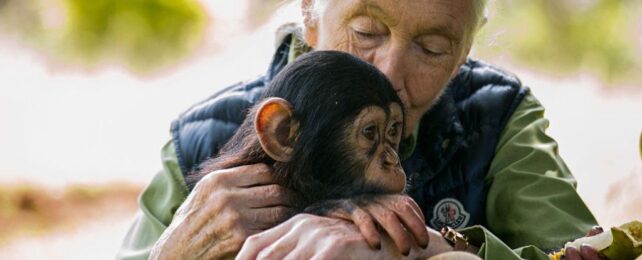Jane Goodall, the world's most famous primatologist, accomplished an astounding feat in her 91 years of life: She fundamentally changed the world's view of what it means to be human.
At the age of just 26, Goodall observed a chimpanzee (Pan troglodytes) in Gombe Stream National Park, Northern Tanzania, use a blade of straw to dig termites out of a mound.
When she told her boss, paleoanthropologist Louis Seymour Bazett Leakey, he replied: "Now we must redefine 'tool,' redefine 'man,' or accept chimpanzees as humans."
In the space of one woman's lifetime, the study of animal tool use has grown from a single blade of straw to a bouquet of functional objects – used by monkeys, crows, dolphins, orcas, humpback whales, and even bees and other insects.
Related: World-Renowned Primatologist Jane Goodall Passes Away at 91
Tool use is no longer considered a defining human trait. Nor is cultural transmission.

Over the decades, Goodall and other primatologists working in various forests of Africa have discovered extensive tool use among chimpanzee populations, with different traditions from group to group and region to region.
Among Gombe chimpanzees, Goodall noticed the animals using sticks, stalks, stems, and twigs for termite fishing, as well as leaves for 'napkins' and 'drinking tools'.

In Gabon, however, scientists observed chimps using sticks to extract honey rather than termites, and in the 1980s, chimpanzees in Guinea were observed using stone hammers and anvils to crack nuts.
For decades, primatologists like Goodall strongly suspected that adult chimps were teaching younger generations how to use sticks and rocks in ways that best suit their habitats, but firmer evidence didn't arrive until 2016.
That year, researchers working in the Republic of Congo observed and filmed chimpanzees teaching their young to use tools to forage for food in a major first.
That particular discovery brought together two of Goodall's greatest contributions to the field: tool use and the strong bonds between mother and offspring.
The findings hint at deep evolutionary roots of teaching and learning among primates – and they suggest that intergenerational cultural transmission isn't unique to humans.
It's also not just confined to mealtimes.
Recently, scientists observed some chimpanzee cultures sticking grass in their ears and butts, much like a social fashion trend.

So if tool use and culture don't set humans apart, then what does? After Goodall's discovery, many scientists turned to language as the defining trait of our species.
Even in that regard, however, chimps continue to surprise us. These primates have a rich vocal communication system, and their hoots, hollers, grunts, lip smacks, and physical gestures hold weird similarities to our own languages. They can also be taught to say some real human words, which suggests they have basic neural foundations for speech.
In a nature reserve in Guinea-Bissau, chimpanzees use the forest like a drum kit, chucking stones against wood to create rhythmic thumps. It's a possible form of long-distance communication achieved via tools.
The late primatologist Frans de Waal doesn't even think morality sets humans apart. De Waal is famous for studying the world's largest captive colony of chimpanzees. In the early 2000s, he discovered that these animals exhibit signs of deception and conflict resolution, and he argued, albeit controversially, that these primates display traits such as empathy and 'moral behavior'.
In 2019, experts studying primates in the forests of Gabon noticed a behavior that supports de Waal's ideas. A female chimpanzee named Suzee clamped what looked like a tiny insect in her mouth and applied it to a wound on her son's foot. Once seen, researchers noticed the behavior frequently in the community.
Looking back through historical documents, scientists have since tallied numerous cases of chimps caring for the wounds of others, using insects, leaves, or munched materials.
"Our research helps illuminate the evolutionary roots of human medicine and healthcare systems," said primatologist Elodie Freymann of the University of Oxford earlier this year.
In an interview in 2012, de Waal said that "Over the years the dividing line between humans, certainly between humans and the apes, has sort of become fuzzy under the influence of field work, such as the work by Jane Goodall… which has shown all sorts of capacities that we had not suspected in the apes."
One of De Waal's last books before he died was titled, "Are We Smart Enough to Know How Smart Animals Are?"
Goodall just might have been. Because of her contributions, research on animal intelligence will never be the same.
